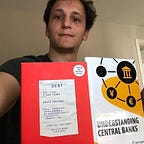Meter.io aims to create a low volatile currency following 10 kWh electricity price.
Meter uses a hybrid PoW/PoS solution; PoW mining for stable coin creation and PoS for txn ordering
- MTR is stablecoin soft pegged around the global competitive price of 10 kwh electricity
- MTRG is the finite supply governance token, which is used by PoS validators to validate transactions.
Pow mining in Meter is as open and decentralized as in Bitcoin but differs from that in Bitcoin in two fundamental ways
1. Block rewards are dynamic. It’s determined as a function of pow difficulty. The wining Meter miner will earn more MTR if hash rate is high and less MTR if hash rate is low, ensuring a stable cost of production for each MTR at 10 kWh electricity price using mainstream mining equipment
2. Miner’s don’t validate transactions. They simply compete to solve PoW. Txn ordering is done by PoS validators who secure the network and in return earn txn fees.
All stablecoins must essentialy have stability mechanisms to account for cases where demand is high and where demand is low. MTR has 2 stability mechanisms set to solve this mission.
Supply side stability mechanism (long term)
First and foremost MTR can’t be produced out of thin air. It’s issuance follows a disciplined monetary policy that solely depends on profit seeking behavior of miners. The only way to issue MTR is via PoW mining. When miners notice that price of MTR is getting higher than the cost to produce them (remember cost of production is always fixed at 10 kwh elec. price = around 0.9–1.2 usd) they will turn on their equipment and start creating new supply. If demand keeps increasing more miners will join, and more MTR will be printed to keep up with demand. Eventually supply will outperfrom the demand and price will get back to equilibrium.
When demand is low and MTR price is dropping below 10 kwh elec. price miners will not risk their profit margin to shrink and switch to mine other coins instead of MTR. In return MTR production will stop and no additional MTR will enter circulation. Given that mining is a competitive, open enviroment, price of MTR will eventually equal to the cost to produce it. (Marginal Revenue = Marginal Cost).
The long term stability is achieved through this unique and simple mechanism at layer 1 which doesn’t require use of capital inefficient collateral, complicated oracles, seignorage shares or algorithmic rebasing mechanisms.
Relative to nation based fiat currencies, switching cost between crytocurrencies is significantly lower. Sudden demand changes in crypto is therefore very common and must be addressed. Huge drop in demand may temporarly cause MTR to get traded below it’s cost of production making pow mining a losing game. How can the system recover from that and restart production? On the contrary, a sudden increase in demand may cause MTR to get traded at a premium making mining temporarly very profitable. Meter has a second layer stability mechanism in order to absorb sudden demand changes.
Demand side stability mechanism (short term)
An on chain auction resets every 24 hours offering newly minted fixed number of MTRGs in exchange for bids in MTR. Participants bid at no specific price and at the end of auction recieve MTRG proportional to their percentage of total bid. The main purpose of this auction is to consume MTR. A portion of MTR (initally %60) that is bidded in the auction ends up going to a reserve that is collectively owned by MTRG holders, essentially getting out of circulation. Future use of MTR in Reserve can be decided by governance. The remaining %40 gets gradually distributed to PoS validators as block rewards. This reserve allocation ratio can be adjusted via governance depending on the amount of MTR needed to be removed out of circulation at any point in time.
Future Road Map
Meter team is working to make Meter compatible with other blockchains. In fact both MTR and MTRG can currently be 1:1 bridged to their Ethereum versions as eMTR and eMTRG respectively. In near term, stablecoin MTR is set out on a mission to serve as collateral and a crypto native unit of account for DeFi.
